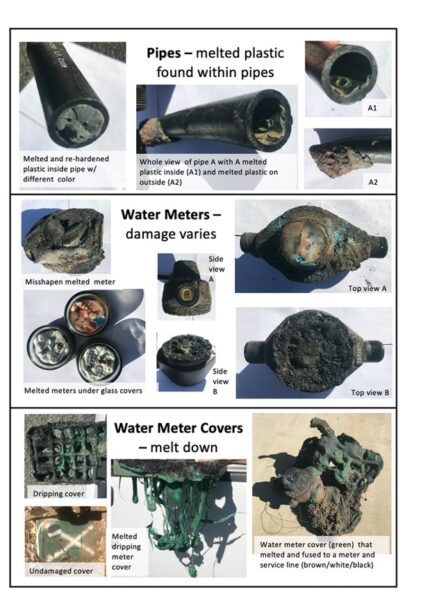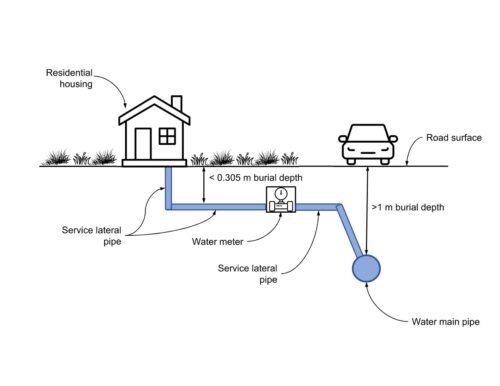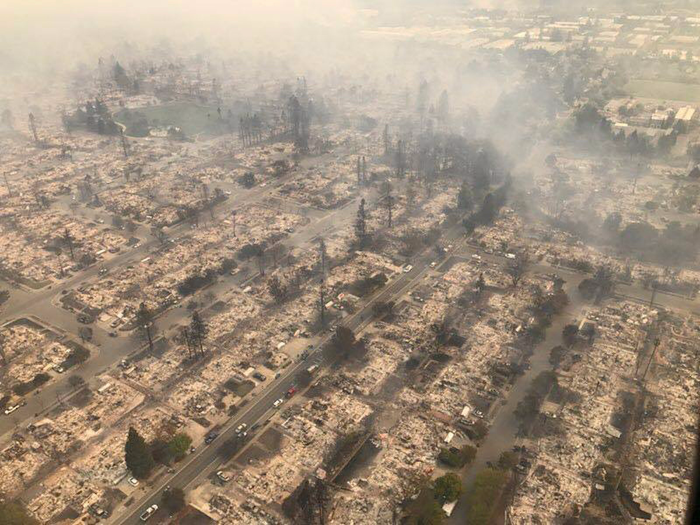Written for Maven’s Notebook by Robin Meadows
The first time a reporter asked public health researcher Gina Solomon if wildfires could contaminate drinking water, she told them it wasn’t a concern. The second time a reporter brought this up, she learned that it was. Tap water collected after the 2017 Tubbs Fire in Santa Rosa, California had just tested positive for toxicants including benzene, a carcinogen, and other volatile organic compounds (VOCs). The latest evidence links these contaminants with plastic pipes.
“The whole issue of benzene and VOC contamination was a stunner to me and many public health experts,” says Solomon, an occupational and environmental health physician who is a principal investigator at the Oakland-based Public Health Institute.
They weren’t the only ones taken by surprise. “Building codes never considered damaged plastic water system materials becoming a source of drinking water contamination,” says Andrew Whelton, who leads Purdue University’s Healthy Plumbing Consortium and Center for Plumbing Safety, and has investigated the role of plastic pipes in VOC-contaminated water since the Tubbs Fire.
This newly recognized health threat is likely widespread in the West. Toxic VOC levels have now been detected in wildfire-damaged drinking water systems in communities including Paradise, California after the 2018 Camp Fire; Santa Cruz County, California after the 2020 CZU Lightning Complex; Detroit, Oregon after the 2020 Labor Day Fire; and, most recently, in Boulder County, Colorado after the 2021-2022 Marshall Fire.
About one-third of households in the continental US are in the wildland-urban interface, a mosaic of homes, grasslands, and forests. Already prone to burn, these areas are increasingly imperiled by catastrophic wildfires as climate change brings hotter, drier summers.
Toxicant sources
Plastic pipes can contaminate drinking water in two ways. Burned pipes can serve as a conduit for contaminant-laden smoke, which gets sucked into damaged water systems as they depressurize.

Heat-damaged plastic pipes can also contaminate water directly. A 2021 laboratory study co-authored by Whelton showed that when plastic pipes burn or even just get very hot, they degrade and release VOCs into water. This finding was confirmed in a similar laboratory study submitted for publication co-authored by Erica Fischer, an Oregon State University structural engineer and hazard resilience expert, and colleagues.
Fires that consume buildings as fuel can blaze for more than four hours and be mindbogglingly hot at nearly 1000 °C. And the nearer houses are to each other, the more severe the fire. A 2020 study co-authored by Fischer showed that the greater the density of burned houses in Santa Rosa and Paradise, the greater the incidence of toxic VOC levels in service laterals. This makes close clustering of houses a good predictor of water contamination after fires.
Most at risk of fire damage are small diameter pipes called service laterals that connect individual buildings to the large water mains running under streets. “The service lateral’s attachment to the house is the vulnerable part,” explains Fischer. “The pipe gets very shallow and that’s where you see high soil temperatures.”
Ground surface temperatures reach 200 °C to 800 °C during fires, depending on factors including fuel type and weather. Plastic pipes begin to release toxic levels of VOCs at 200-250 °C, depending on the type of plastic. After the fires in Santa Rosa and Paradise, service laterals were damaged throughout the water systems and nearly one-fifth were contaminated.
Wildfire resilience
Plastic pipes also have considerable benefits, including affordability and earthquake resistance, and the Paradise Irrigation District is replacing its contaminated plastic service laterals with new plastic service laterals. But the district is also taking the precaution of equipping each new service lateral with a backflow preventer, which will help keep toxicants from flowing backwards out of a house and spreading widely through the municipal water distribution system.

Now Fischer leads a team that is working on another engineering fix to contain water contamination: sensors that indicate when pipes have gotten hot enough to release VOCs. The sensors are being developed by University of Minnesota structural engineer Lauren Linderman, and the team hopes to field test prototypes of two different kinds this fall.
One is an RFID sensor, which doesn’t need batteries and, when triggered, emits a signal that can be scanned. The goal is to put the RFID sensors on fire hydrant laterals, which are spaced evenly throughout communities and buried at the same depth as the vulnerable part of service laterals.
The second is a color-indicator sensor to let homeowners know if they should replace their pipes after a fire. “There’s a gray area where a pipe is not melted but still reached the critical temperature for contamination,” Fischer says. “You can’t always tell just by looking.”
Water system recovery
Guidelines for water system recovery after wildfires are hampered by uncertainty over exactly which contaminants are present. So far the compounds tested for have been inconsistent, varying among water agencies and testing companies. “They have no idea what else is in the water,” Whelton says. “There could be something they didn’t look for.”
When Colorado officials invited Whelton to investigate water contamination after the Marshall Fire, he instituted broader contaminant testing as a first step towards setting standards. “We need to start making evidence-based decisions on what to look for and where,” he says.
Another pressing need is increased testing capacity so water agencies can get results in real time. “Testing companies are overwhelmed and state agencies don’t have the staff,” Whelton says. “We need a national rapid testing unit.”
With more than 60% of the West experiencing severe to exceptional drought, getting the word out on water contamination after wildfires is also critical. Whelton has just returned from leading a workshop on wildfire response and recovery for concerned water agencies from California, Oregon and Colorado. However, he notes, the threat of wildfires to drinking water is far from just a Western issue and “the majority of water agencies are unaware of it.”
- Andrew Whelton’s Center for Plumbing Safety
- Oregon Health Authority’s Wildfire information for water systems



